After our wonderful time in Siem Reap, it was time to move on. And move on we did, with an overnight bus to the southern beach paradise of Sihanoukville. The bus itself, however, was no paradise.
At around 7 PM, a tuk-tuk came and picked us up from our hotel, drove us two blocks, and had us get out at the bus stop, so we could stand and wait a full hour for our bus to board. What was the point of the tuk-tuk? We could have easily walked, and arrived to the bus station only 20 minute before the bus left instead of having to wait for an hour. Then, when we boarded the bus, it was pandemonium – everyone had assigned seating, but nobody seemed to want to obey their assigned seating. And there happened to be three people with the same seat number 5, which didn’t help matters. And worse, our assigned seats were the very back seats, the ones that don’t recline. That is not where you want to sit on an overnight bus. We ended up sitting separately in single seats, and their leg room made economy on an airplane feel luxurious. A few people seated beside me were fairly tall, and their legs were constantly crushed if the people in front reclined even a little bit. Not the most comfortable ride we’ve ever had. At least there were no chickens on the bus.
Arriving at 7 AM and short on sleep, we were a bit grouchy, and just wanted to find a hotel. The tuk-tuk driver we hired kept insisting on taking us to guest houses that presumably paid high commissions for him, and were not nice. Finally he let us out at a place near the beach (GST guest house – important later), and we pretended to be interested in this one, and then walked out. We ended up finding a really beautiful bamboo bungalow just up the hill from the beach, so it had a beautiful view of the bay. And for the next few hours, we slept.
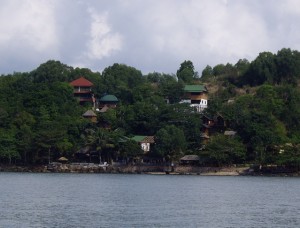
Our beach bungalow viewed from the water
Sihanoukville was not what we were expecting. Perhaps we’ve been spoiled by the extraordinary beaches of Thailand, but we didn’t enjoy this one as much. It could have been the garbage floating in the water, the dirty beach, or the constant flow of hawkers on the beach trying to sell you cheap sunglasses or bracelets, or trying to shave your body hair with string. And at least the guys in other beaches will leave you alone if you’re sleeping – the ones here would wake you up to offer you their incredible deal that you couldn’t possibly want to pass up, no matter how good that dream is. And then there are the starving people (like off the save the children of Africa info-mertials) that come up to you asking for change while you’re eating – how can you in good conscience enjoy your cocktail or beer while this person in front of you can’t afford to eat, let alone feed their children (which they’d often be carrying)? We donated generously but the feeling of helplessness – that you can’t help all of them – just doesn’t go away. We’ve since been told that the beach we stayed at was the worst beach of the region and a much nicer one, a private beach owned by a 5-star resort, was a small tuk-tuk ride away.
On our second day, we hired a tour of Bamboo island, one of the must-see things to do in Sihanoukville. We boarded a long-tailed boat early in the morning and made the trek out to the island. Along the way, we were supposed to go snorkelling at various locations, no less than three locations to be exact, but the quality of the snorkelling was terrible. The visibility was about 3 meters, the coral was colourless, and the masks we were given were the worst we’ve ever used – they fogged up constantly and the snorkel tasted foul.
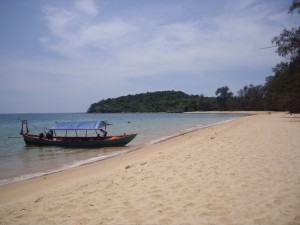
The beautiful beach on Bamboo island
However, Bamboo island itself was beautiful. We stayed on one side for about an hour and were given lunch there, and then walked across the island to the other side. The beach on the other side was stunning – easily one of the nicest beaches we’ve seen – and there was very little development on it. Save for a few bamboo huts and a bamboo restaurant, it was perfect (kind of how we felt about in Ao Thong Nai Pan Noi in 2006).
We were planning on spending up to five days in Sihanoukville, but just weren’t feeling the love for the place, so we moved up our schedule, got on a bus to Phnom Penh the next morning. Our hotel had instructed us to wait for pickup at the GST guest house, as our guest house didn’t have road access. But the pickup never came. We asked the GST guest house to call the bus people for us, but they said “if you had booked through us we could have, but no.” Not only that, but they told us to wait for half an hour before telling us they wouldn’t call, during which time we thought that they were working it out for us. So, with only a few minutes for the bus was scheduled to leave, we got our own tuk-tuk to take us there, and boarded the bus just as it left. When we arrived at the bus station, we told our bus people that they had forgotten to pick us up and that they should pay for our tuk-tuk– their reply to this what that it was our fault, and that we hadn’t seen the driver. Riiight…because we’d been there for over two hours (we ate lunch at a restaurant right next to the pick up zone). That’s how it is in this country – kind of every man for himself attitude.
Phnom Penh
We arrived in Phnom Penh and managed to find ourselves a guest house, after the one we had booked ended up being full. The following morning, we embarked on what was surely to be the most depressing day of our trip – touring the Killing Fields and the torture prison S-21.
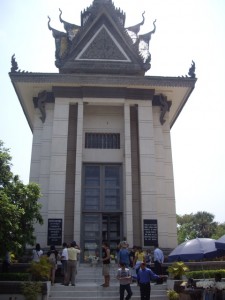
The stupa
During the Khmer Rouge regime in 1975-1979, the Khmer Rouge embarked on a genocidal campaign that ended up killing between 1.1-2.5 million people, depending on who you talk to. The leaders of the regime were so paranoid about enemies within their ranks, that they killed anyone who they thought posed a threat to them, including their families and babies. No one was spared the paranoia – many of Pol Pot’s good friends were executed in this way when their loyalty came into question.
The Killing Fields was an area just outside of Phnom Penh where many of the executions took place. Before 1975, it was a Chinese cemetery, and the Khmer Rouge didn’t even bother to pull up the old Chinese graves before transforming it into a batch of mass graves – the old coffins are still visible. Interestingly, we had joined a tour with a Chinese Malaysian family who, upon seeing one of the headstones, claimed that they had family buried here!
At the Killing Fields, people were driven from detention in Phnom Penh to the area, where they were beaten to death with bamboo sticks and then tossed into mass graves and covered with DDT to stop the smell. The Pol Pot regime was so secretive, they didn’t want anyone knowing about their gruesome activities, even the peasants that lived around the fields. They blared loud music while they did the killing to hide the screams of their victims and no one ever spoke about it. It was only after the regime was toppled in 1979 that the full extent of the atrocities was known.
Now there’s a museum at the Killing Fields and a large stupa containing all the bones that were dug up from the mass graves. We toured the stupa and the grounds, seeing the holes where the mass graves used to be. There was also a tree, still stained with blood, that they used to kill babies – they would literally hold the babies legs and smack its head against this tree before throwing it into the mass grave – all in front of their mother’s eyes. Babies were not spared any mercy, as the Khmer Rouge didn’t want to have babies grow up to exact revenge for their parents’ death. To make matters worse, the Khmer Rouge targeted the highly educated people, as it was easier to control the peasant farmers. Imagine trying to rebuild a country now, without all of the intellectuals, teachers and skilled workers that you once had in abundance. In the rainy season, the the mud becomes very liquid and bones can still be seen floating to the surface – we walked over a patch of dirt where fresh bones were popping out. Overall it was a pretty disgusting scene.
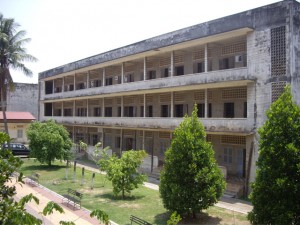
S-21, a former high school turned prison
To top that, we headed over to S-21 next. This was a prison where the most important victims of the Killing Fields could be tortured and interrogated before being taken to the Killing Fields. After the Khmer Rouge took power in 1975, within 3 hours, they had evacuated the city of Phnom Penh, as the urbanites were considered as supporting the previous regime, even though they welcomed the Khmer Rouge with open arms and celebrations, hoping that they were the end of war. In the following weeks, they abolished money, schools, hospitals and anything modern because it wasn’t the model ideal of communism, and everybody was forced into the countryside to plough rice fields. Within hours of emptying Phnom Penh, they saw the need to begin removing their “enemies,” so they converted a high school into a prison, and this became S-21.
Our tour guide for S-21 was a woman named Maley, who was a teenaged resident of Phnom Penh when the Khmer Rouge took power. Her and her family were forced out of the city, and forced to walk for 3 months to Battambang in the hottest month of the year. She remembered the highway being littered with bodies of people who died of exhaustion and starvation along the way. Once she arrived in Battambang, they were set to work in the rice fields. Her father and brothers were all executed, but her mother and her survived. Eventually, after 1979, they returned to Phnom Penh, and her mother is still alive and well.
Sadly, Pot Pot was never tried for his crimes, as he died of natural causes in 1998 while awaiting trial. Today, the remaining leaders of the Khmer Rouge are awaiting their own trial for the atrocities committed against the people, and we can only hope that they are given no remorse.
A Better Day
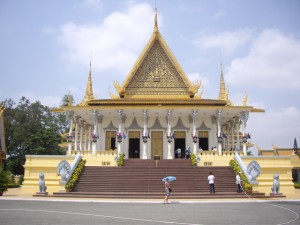
The king's palace and current residence
The next day was much more upbeat, as we toured the more pleasant sides of Phnom Penh. We started off by heading to the Vietnam Embassy for our Vietnamese visa, and then headed to the king’s palace and the silver pagoda. The most interesting thing in the palace was a 90 kg buddha made of pure gold, dotted with over 2000 diamonds, the largest being over 25-carats – the size of a grape. Unfortunately, we were not allowed to take a picture of it, there were guards everywhere. Shame. Then we took a long walk, made longer by the excruciating heat (heat index of 44°C) over to Wat Phnom, a Buddhist temple in the middle of Phnom Penh. During the Khmer Rouge regime, they were actually going to take down this temple and put up communist statues of Pol Pot, and the only reason they didn’t was because the Vietnamese invaded and toppled the regime. It would have been a shame if they had, this temple was really beautiful.
At the top of the temple, a teenaged girl was selling small birds that you could buy for $1 and “liberate.” Kenna is such a sucker, she actually went for it. I was horrified. (Kenna’s note: I felt a need to set the poor bird free from the girl’s grasp…but once I did it, I realized the birds are probably trained to fly back to a certain place, where she just captures them again. My intent was good, I swear. :))
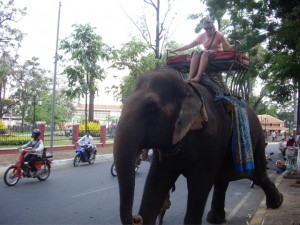
Kenna riding an elephant through traffic
Outside the temple was an elephant, which you could pay to take a ride on. Normally we wouldn’t indulge in such a thing, since having an elephant in the middle of a city is quite cruel, but we’re planning on doing some elephant trekking in the jungle in Thailand in a month or so, and Kenna was very afraid that she’d be allergic to it. So, as a test of her allergies, we got her on the elephant and paraded her around for a bit. In the middle of traffic. It was really funny – the locals looked at her like she had three heads, and even military officers riding in the back of trucks laughed at her…
The Vietnamese Embassy – Our first taste of Vietnamese bureaucracy
We were supposed to return to the Vietnamese Embassy at 4:30 to claim our visas, but we decided to get ahead of the crowds and go a bit earlier at 3:30. After all, we had been there really early in the morning, it should be ready by now right? All they have to do is stamp a piece of paper, and our Cambodian and Indonesian visas were issued in five minutes.
Well, we arrived, and were told that they weren’t ready yet, except the guy didn’t even check if they actually were ready. So we waited. By 4:30, the waiting room was packed full of people, even standing room was cramped. And still we waited. At 4:30, the guy behind the desk suddenly became really busy stamping and writing on the massive stack of passports he had collected – had he really waited until exactly 4:30 to start issuing visas? We had dropped off our passports at 9:30! After a lot of tension from antsy people and almost 90 minutes of waiting, we finally got our passports.
Thinking the fun was over, we headed out of the passport office to our waiting tuk-tuk. We had negotiated a price of $4 for the pickup from our previous location, Wat Phnom, to the Vietnamese Embassy and back to our hotel, but the driver was now claiming $4 per person. $4 was actually quite generous, as we had paid $3 to come to the embassy earlier in the day, and $8 was just outrageous. To make matters worse, our tuk-tuk driver spoke very little English and was having to talk to another driver who was translating for us. Meanwhile, an American couple, whom we had met while waiting in the embassy, came up to us and asked to join our tuk-tuk, so we told our driver that he could take all of us for $5. It seemed the problem was solved and everyone was happy…until… we got to our hotel, the driver suddenly wanted $6, as he claimed that he meant an extra $1 per person and only saw 3 of us… this was B.S. so we walked away. He had changed the price on us three times now, and this is not cool – in these countries, when you agree on a route and a price and shake on it, it’s like signing a contract. We’ve never had a problem before. The American couple told us to go ahead, they would handle it – they said that it was their dollar to pay and they didn’t think it was fair, so we went inside our hotel.
The American couple was in a hotel a little further than us, so they started walking down the street, and the very perturbed driver started following them and hassling them. He started raising his voice, which is very rude in these countries, so much so that I’ve never seen anyone raise their voice. He was obviously pissed. From the safety of the second floor of our hotel, we watched as he actually got violent with the other couple – he took the woman and shook her. They got freaked out and walked into the lobby of our hotel, and the driver followed. We headed back downstairs to see if we could be of assistance, and the driver continued to yell at us until our hotel threw him out. Still he persisted outside, and came back into the hotel again, only leaving after being tossed out yet again. That was a bit of a jarring experience – I would have just paid him the $1 and been done with it, but the Americans were insistent that we shouldn’t pay.
Impressions of Cambodia
Overall, Cambodians are a very nice people, and that crazy tuk-tuk driver was the only exception. Even the hotel staff thought he was a little crazy. Given Cambodia’s brutal past and the constant reminders of it, it’s impressive that they’re as nice and welcoming as they are. However, travelling Cambodia hasn’t been one of our favourite experiences, as it’s definitely got it’s fair share of hassles. It gets really tiring when one has to be wary of scams everywhere, of bad deals and thefts, of less-than-honest tour guides and drivers, and of poorly organized transportation. I kept joking that the only reason we haven’t been really ripped off here is that the people are generally too disorganized to run a really good scam. Even the guy we met walking around Phnom Penh who had a perfect American accent and wanted us to lend him money cuz he’d been ‘mugged’ was a bad con, and easily seen through.
That being said, the next time we come here, we’d like to volunteer. We had tried to visit a few orphanages, but they really like you to have a long-term commitment to avoid traumatizing the children too badly from too many people in their lives. As we said, seeing all the poverty everywhere really dampens your ability to enjoy a place, but we did enjoy our time there and hope that our contributions to the economy help improve the situation for the lovely people of this country.


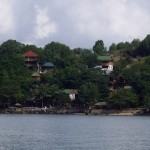

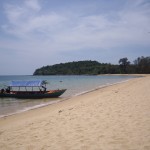
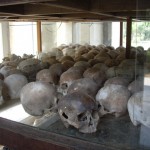
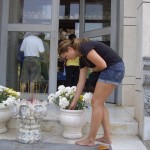
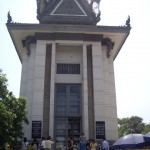
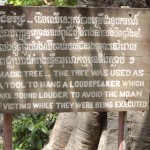
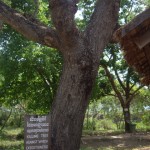
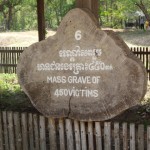
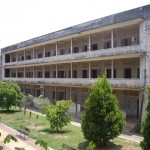
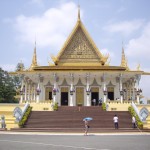
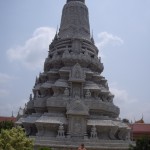
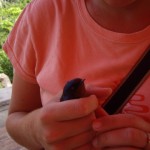
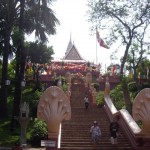
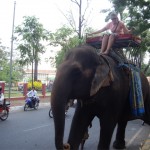
Wow. I can’t believe all those murders happened in 1975-1979!!!!!!! That is not that long ago! How absolutely devastating. I cannot possibly imagine something so horrendous happening.
Keep up the amazing blog posts! They always make my morning! 😉
Some creative commerce going on there. Poor little birdies.
Sad for the Cambodians.
Kenna I personally don’t think you got sucked in at all. You are providing income for that person and his birds (good thing) who will continue to look after the birds in a controlled (probably good thing) environment. I would imagine these little guys would be fairly low on the food chain so by keeping the birds “captive ” they are quite probably living a better (and certainly longer) then they would in the wilds. Remember Buddha says “Try and look at the positive in all situations. By doing so you will often find that a thing or action has both good and bad consequences. Our duty on the road of life is to try a find the good consequences and minimize the bad.”